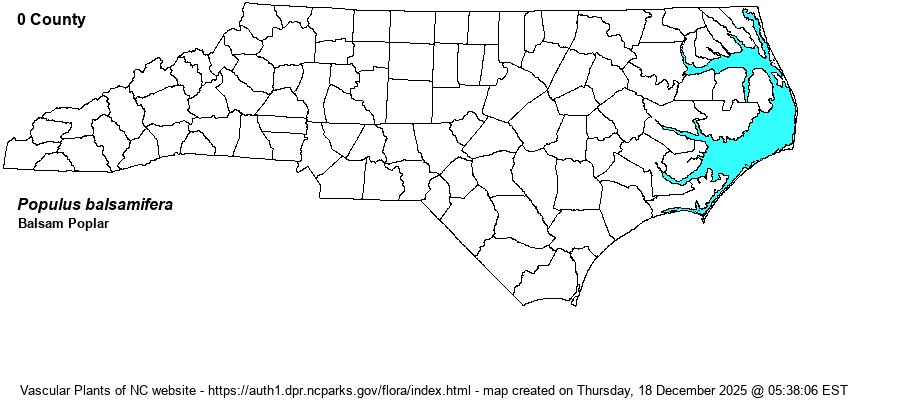| Author | L. | |
| Distribution | At SERNEC there are no unequivocal specimens of Balsam Poplar from NC, except planted trees at the NC Zoo. Specimens from Haywood and Wilkes counties do not have images or label data, so cannot be accepted. Other specimens from Ashe, Edgecombe, Macon, and Swain counties are misidentified and actually are P. x jackii (= P. candicans). FNA does not map it in NC, though Weakley's (2018) map shows it as rare in the NC Mountains (but non-native). Though the map below shows no counties at present, the editors feel that it should remain on the NC flora list until the dust settles.
Native of most of Canada and the northern U.S., south to WV, IL, CO. | |
| Abundance | Unknown. | |
| Habitat | Unknown. In its native range, it grows in various cool forests, doing best in floodplains. | |
| Phenology | Flowering - no data. | |
| Identification | Balsam Poplar can grow to be a tall, narrow-crowned, old tree, but most often is short-lived. Leaves are ovate, crenate-toothed, much paler beneath (but not whitish), usually with rusty colored "resin stains" beneath. The reddish twigs and leaves have a sweetly pungent fragrance. P. x jackii has broader leaves that are more triangular in shape, whitish beneath, and with at least some of the veins pale as in Eastern Cottonwood (P. deltoides). | |
| Taxonomic Comments | | |
| Other Common Name(s) | | |
| State Rank | SE | |
| Global Rank | G5 | |
| State Status | | |
| US Status | | |
| USACE-agcp | FACW link |
| USACE-emp | FACW link |

